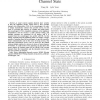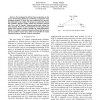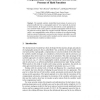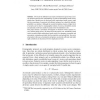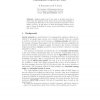108
click to vote
GLOBECOM
2010
IEEE
14 years 11 months ago
2010
IEEE
A usual concern against physical layer security is that the legitimate parties would need to have (partial) channel state information (CSI) of the eavesdropper in order to design t...
118
click to vote
ENTCS
2000
15 years 24 days ago
2000
We lift Cardelli, Ghelli and Gordon's secrecy group creation operator [1] to a relative of the spicalculus that supports symmetric key cryptography, and show a natural extens...
87
Voted
ENTCS
2007
15 years 28 days ago
2007
We present a powerful and flexible method for automatically checking the secrecy of values inside components. In our framework an attacker may monitor the external communication ...
105
click to vote
CORR
2007
Springer
15 years 29 days ago
2007
Springer
—The focus of this paper is an information-theoretic study of retransmission protocols for reliable packet communication under a secrecy constraint. The hybrid automatic retransm...
CORR
2006
Springer
15 years 1 months ago
2006
Springer
We consider the General Gaussian Multiple Access Wire-Tap Channel (GGMAC-WT). In this scenario, multiple users communicate with an intended receiver in the presence of an intellige...
121
click to vote
CORR
2008
Springer
15 years 1 months ago
2008
Springer
We investigate the effects of user cooperation on the secrecy of broadcast channels by considering a cooperative relay broadcast channel. We show that user cooperation can increase...
CORR
2008
Springer
15 years 1 months ago
2008
Springer
Equivocation has been widely used as a measure of security after Shannon[10]. For an infinite system such as the wiretap channel defined in [2], equivocation is unbounded and so e...
103
click to vote
FSTTCS
2006
Springer
15 years 4 months ago
2006
Springer
The standard symbolic, deducibility-based notions of secrecy are in general insufficient from a cryptographic point of view, especially in presence of hash functions. In this paper...
100
click to vote
CSL
2006
Springer
15 years 4 months ago
2006
Springer
Abstract. Two styles of definitions are usually considered to express that a security protocol preserves the confidentiality of a data s. Reachability-based secrecy means that s sh...
107
Voted
FSTTCS
2003
Springer
15 years 6 months ago
2003
Springer
Tagging schemes have been used in security protocols to ensure that the analysis of such protocols can work with messages of bounded length. When the set of nonces is bounded, this...
